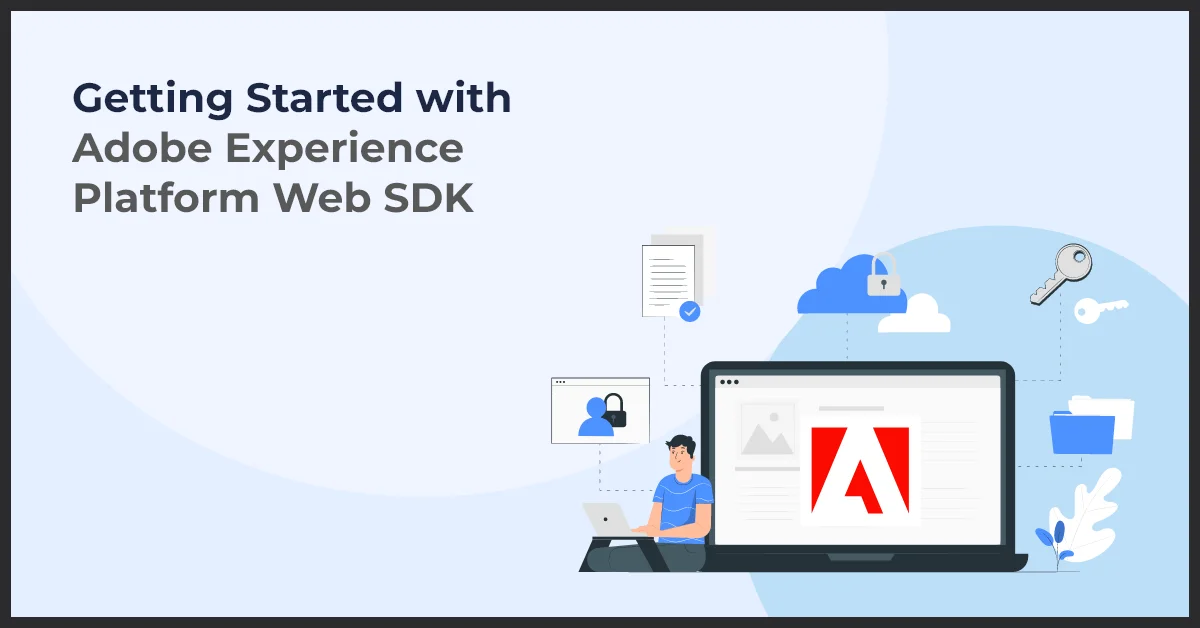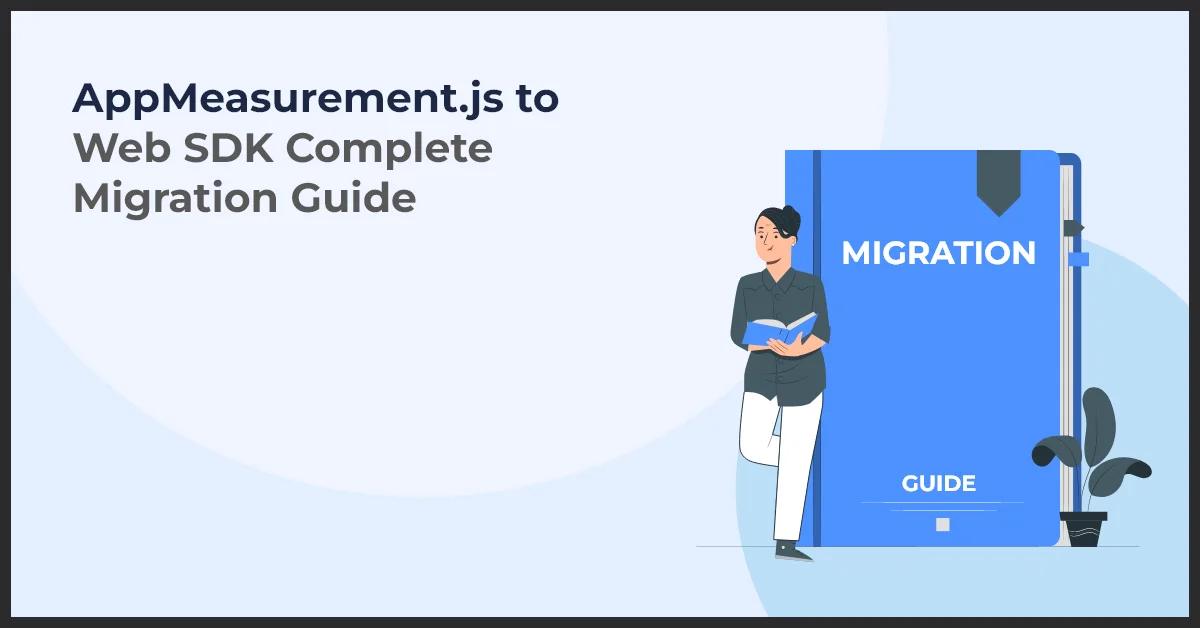Complete Process for Integrating GA4 with Data Warehouses and Business Intelligence Tools
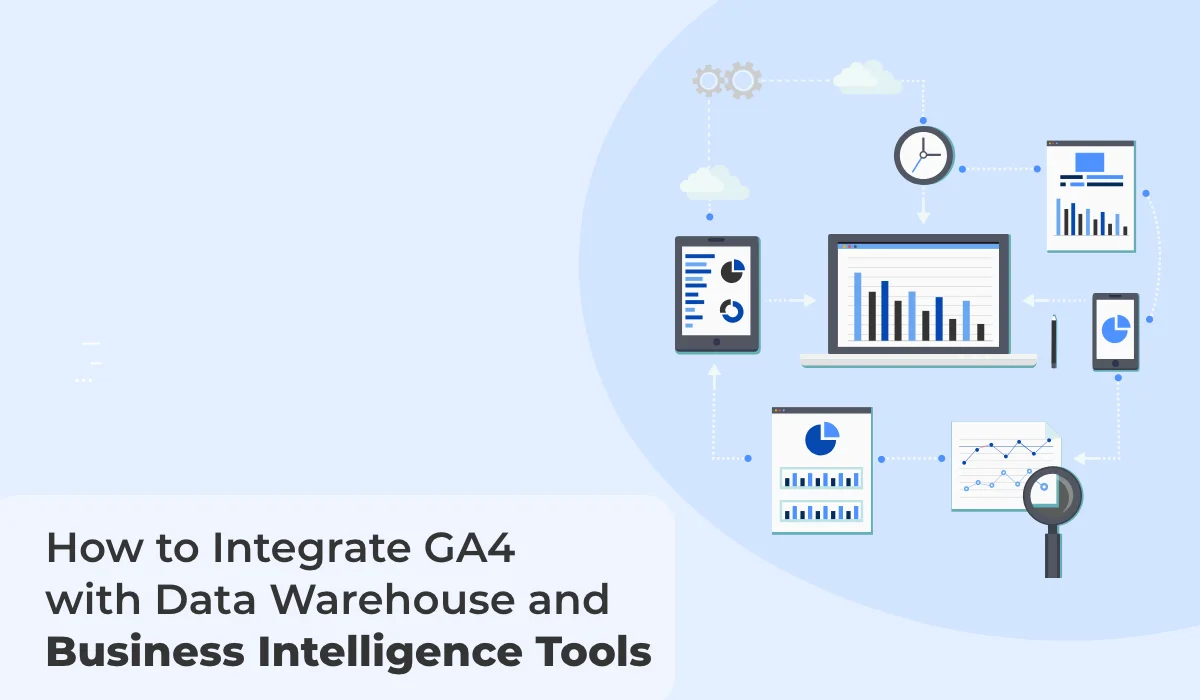
Published on: July 27, 2023
Updated on: March 11, 2025
3063 Views
- Analytics
26 min read
The process has finally begun, and Google has brought down the curtains on Universal Analytics. Since July 1, 2023, Google has stopped processing hits, including standard properties in Universal Analytics. The search engine giant had started automatically creating GA4 properties for existing users who hadn’t created GA4 properties by themselves.
Millions of website owners and marketers now must undergo forced migration to Google Analytics 4, or GA4. The historical UA data will be available until July 2024. In this write-up, we shall cover the basics of GA4 and discuss how to integrate GA with data warehouse and BI tools.
Google Analytics 4 (GA4) - Overview of GA4 and Its Key Features
Google Analytics 4 is a completely new version of analytics. It isn’t an incremental change over Universal Analytics but a complete overhaul. The focus has shifted from tracking traffic to engagement. Unlike its predecessor, it isn't a web-only tracking tool but introduces app tracking to align itself with the realities of a cross-platform world. It has been long awaited in the marketing industry as marketers had to rely on UA and other app tracking tools.
With this new analytics tool, you can track customers' complete journey and interaction with your web and app platforms on a single dashboard. You gain deeper insights that will influence your campaigns and optimize your digital presence across all the platforms. GA4 leverages AI (artificial intelligence) and ML (machine learning) and lets you gain detailed insights into how customers interact with your website and apps. It is no longer about where the users come from and where they go but what they do during those engagements.
Key Features of Google Analytics 4
Insightful Dashboard
The updated dashboard is the first thing one notices when using GA4. It is more insightful than the Universal Analytics dashboard. On this new, cleaner dashboard provided by GA4, creating and maintaining audiences from web and mobile apps is simple.
Event-Based Tracking
This feature has received the most attention. While in UA, the emphasis was on page views, sessions, and users, GA4 gives you the complete picture of an event. You may feel anxious about this functionality, but it enables us to get more precise data for campaign optimization.
Privacy Controls
Privacy is a major issue in the digital ecosystem with recent legislations such as the EU’s General Data Protection Regulation and California Consumer Privacy Act. GA4 focuses on privacy and provides sophisticated capabilities that enable you to maintain compliance with GDPR while controlling the user data you collect and how you use it in your campaigns.
Customization
GA4 gives more power to you. You can customize your dashboard and view the reports that matter. You may build unique visualizations based on the event data on your web and app properties if you currently use Google Data Studio.
Importance of Data Warehousing, Business Intelligence (BI) Tools
We have already covered the basics of Google Analytics 4, and now let us focus on the most important aspect of this write-up. Data Warehousing collects, organizes, and stores large volumes of data from various sources in a centralized repository. It can involve transforming raw data into a structured format for querying and analysis. BI Tools are software applications that let you retrieve, analyze, and visualize the data stored in the warehouse to gain insights.
Key Components of a Data Warehouse
Raw Data Storage
It is the first component of your data warehouse. It is where the data warehouse stores the raw, unprocessed data collected from GA4. It can include event data, user interactions, events, associated parameters, and user and session information.
Data Integration
The data warehouse integrates data from multiple sources, including GA4, to create a unified data view. It allows data consolidation from various platforms, such as websites, apps, and other digital properties, into a single location.
Data Transformation
The raw data is transformed into a structured format suitable for analysis and reporting. Your raw data undergoes cleaning and normalizing before it is organized to ensure consistency and accuracy across different data sources.
Data Modeling
In this process, data models define the structure, relationships, and hierarchies within the data warehouse. The GA4 data model can align with the event-driven data structure, allowing for flexibility in capturing custom events and parameters.
Data Aggregation
Aggregating data allows consolidation of the raw data to create meaningful metrics and dimensions. It enables faster querying and analysis by pre-calculating common calculations, such as totals, averages, and counts.
Data Security and Governance
Data security covers access controls, encryption, and other security measures to protect sensitive data. Data governance ensures data quality, compliance with regulations, and adherence to data management policies.
The Process of Integrating GA4, with a Data Warehouse; Connecting and Syncing
The integration of GA4 with a data warehouse is a step in unlocking the potential of your data and maximizing its value. By connecting these two tools you can delve deeper into understanding your website's performance. Make informed decisions for your business. In this section we will explore the process of integrating GA4 with a data warehouse highlighting the significance of data synchronization and ensuring consistency.
The Significance of Data Synchronization and Ensuring Consistent Data
Maintaining accuracy and consistency across your analytics and business intelligence systems heavily relies on data synchronization. This process involves transferring data from GA4 to your data warehouse ensuring that both datasets are aligned and kept up to date. Through synchronization you can avoid discrepancies. Confidently base your decisions on reliable information.
An Overview of the Steps Involved in Connecting and Syncing Data
Connecting GA4 with a data warehouse requires steps to facilitate data transfer between these two systems. Here's an overview of the integration process;
Step 1 - Evaluate the capabilities of your data warehouse along with its compatibility with GA4. Make sure that your chosen data warehouse has the infrastructure and tools to handle GA4s data effectively.
Step 2 - Establish connections by setting up access permissions and credentials, in both GA4 and the designated data warehouse.
Step 3 - Start by identifying the data elements that you want to transfer and synchronize between GA4 and your data warehouse. This involves defining the metrics, dimensions and events that align with your objectives.
Step 4 - Next configure the data exports, in GA4 to send the selected data elements to your data warehouse. You may need to create custom data streams or use predefined connectors provided by your data warehouse platform.
Step 5- Ensure alignment and consistency by mapping the data fields between GA4 and your data warehouse. It's important to establish mappings for dimensions, metrics and events to avoid any discrepancies in the transferred data.
Step 6 - To ensure accuracy and completeness of the transferred data it's crucial to test the integration and synchronization process. Monitor the flow of data. Address any issues that may arise during this testing phase.
Step 7 - Implement a schedule for synchronizing your data to keep your data warehouse up to date with the insights from GA4. Wherever possible automate this process to minimize efforts and ensure availability of updated information.
By following these steps you can establish an integration between GA4 and your chosen data warehouse. This will enable transfer and synchronization of information unlocking limitless possibilities, for advanced analysis and informed decision making using powerful business intelligence tools.
Benefits of Integrating GA4 With a Data Warehouse and BI Tools
Integrating Google Analytics 4 with a data warehouse and business intelligence (BI) tools enhances your organization's data analytics capabilities. Let us take you through some of the biggest incentives of this integration.
Thorough Data Analysis
You can combine data from multiple sources and gain a holistic view of your organization's performance. You can analyze GA4 data alongside internal and external datasets, allowing thorough data analysis to gain deeper insights.
Advanced Analytics
A data warehouse provides a robust and scalable infrastructure for storing and processing large volumes of data. With GA4 data in the warehouse, you can leverage advanced analytics techniques, such as predictive modeling, machine learning, and data mining, to uncover valuable patterns, trends, and correlations in your data. It creates an environment for accurate predictions and actionable insights.
Tailored Reporting and Dashboards
BI tools offer powerful visualization capabilities that allow you to create customized reports and dashboards. By integrating GA4 with BI tools, you can design visualizations that align with your business needs, making tracking key performance indicators (KPIs), monitoring trends, and sharing insights across your organization easier.
Enhanced Data Governance and Security
Integrating GA4 with a data warehouse allows you to maintain a single source of truth, improve data quality, and ensure compliance with data privacy regulations. A data warehouse provides a centralized and controlled environment for managing data. It enables you to implement data governance policies, enforce security measures, and ensure data integrity.
Higher Scalability and Performance
GA4 generates a vast amount of event-based data, which can impact the performance of your reporting and analysis if not handled efficiently. Integration with a data warehouse lets you offload the data processing and storage workload to a scalable infrastructure for handling large datasets.
Long-Term Data Retention
GA4 has data retention policies, which may limit the availability of historical data. By integrating GA4 with a data warehouse, you can store and retain historical data for as long as you need, enabling you to perform long-term analysis and comparisons. It is important for your organization if you need access to historical data for strategic decision-making or regulatory compliance.
Setting Up GA4 Property and Data Streams
Before we discuss the steps of setting up data streams, let's start with the fundamentals. Data streams are a new component in the GA4 structure. They are similar to Views in Universal Analytics. Whereas in Universal Analytics, you had unique properties for different sources of data, i.e., websites and apps, GA4 has abandoned that process. In the present structure, you have one Analytics property with data streams. You can integrate data from different sources - the website, iOS app, and Android app in a single GA4 property. You can apply filters directly to your report to track data from each stream.
Configuring Data Collection in GA4
Configuring data collection in GA4 is easy. In three steps, you can set up and use your data streams. If you're setting up your data streams for the first time, take the following actions –
Step 1 – Navigate to the “Admin” section of the GA4 account. You will find it in the bottom left.
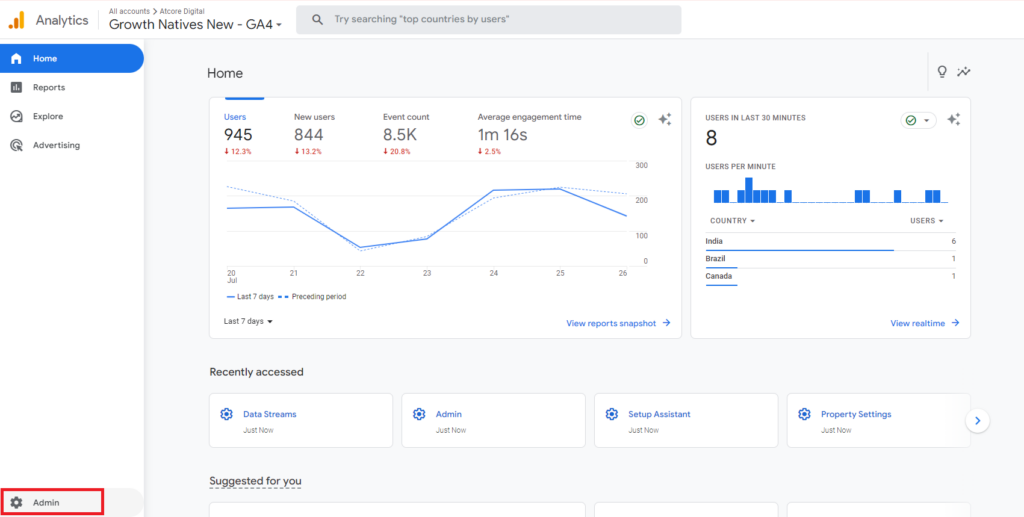
Step 2 – In the “Admin,” you will find “Data Streams” under “Property.” If you don’t have an existing property, start by creating one.
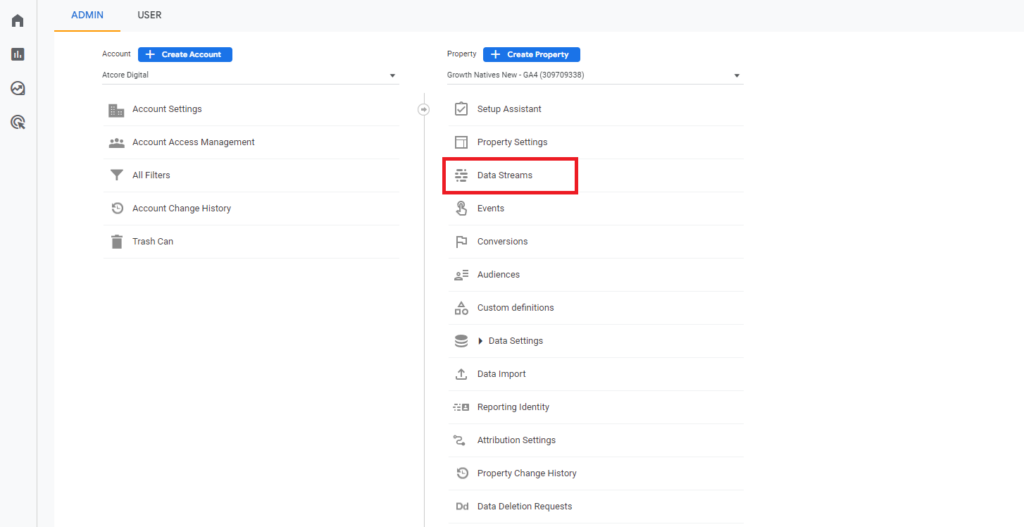
Step 3 – In this step, you need to add a new data stream (website, iOS App or Android App). If you have already added them, you can configure them.

GA4 Data Schema and Event Tracking
GA4 has introduced a new data schema and event-tracking model. The new schema provides more flexibility and support for complex data analysis. Compared to Universal Analytics, it takes tracking to a whole new level. Here are a few highlights of GA4 data schema and event tracking -
- Event-Driven Model: GA4 comes with an event-driven model, where events are the core unit of measurement. Events represent user interactions with your website or app, and you can categorize them into predefined event types (page_view, purchase, sign_up) or custom events you define.
- Event Parameters: In GA4, each event can have associated parameters that provide additional information about the event. For example, a purchase event might include parameters like transaction_id, item_name, and item_category. Thus, you can capture and analyze more specific details about user interactions.
- Flexible Event Structure: Universal Analytics had a major downside with its fixed hit-based model. With GA4, you can define custom events and parameters based on your specific tracking requirements. This flexibility enables you to track user actions beyond the standard predefined events.
- Enhanced Measurement: The enhanced measurement features automatically capture certain user interactions without an explicit event tracking code. For example, GA4 can automatically track video engagement, file downloads, outbound link clicks, and more.
- User-Centric Data Model: GA4 focuses on a user-centric data model, where individual user interactions are linked using an anonymous User ID or device-specific identifiers. This feature allows you to analyze user behavior across multiple sessions and devices.
- BigQuery Integration: GA4 directly integrates with BigQuery, Google's data warehouse solution. It allows you to export your raw GA4 data to BigQuery for advanced analysis and custom reporting.
Key Metrics and Dimensions for Integration In GA4
In GA4, you can integrate and utilize several key metrics and dimensions to gain insights into your website or app performance. Let us dig into some of the most important metrics and dimensions in GA4:
Key Metrics in GA4
These are quantitative measurements of your data and let you gain deep insights into the performance of your website or app.
- Active Users: It is one of the most important metrics and measures the number of unique users who had at least one session within the selected time.
- Sessions: With this metric, you can track the number of sessions (user interactions) within the selected period.
- Engaged Sessions: The measure of engagement on your website or app leads to a certain activity, such as form filling or a download.
- Engagement Rate: This is the average duration of sessions in seconds and gives you insights into the quality of content on your page.
- Conversion Rate: It is the percentage of users who completed a specific goal or conversion event.
- Revenue: Perhaps the most important metric, especially for ecommerce sites, is the total revenue generated from transactions or other monetization events.
- Retention: Here, you can measure the percentage of users who return to your app or website over a specific period.
Key Dimensions In GA4
GA4 dimensions are an attribute of your data. When you track the dimensions, you gain a bird’s eye view of the performance of your property.
- User ID: It is an anonymous identifier for analyzing user behavior across multiple sessions and devices.
- Device Type: As the name suggests, it helps you identify the type of device the user uses while browsing your platform.
- Traffic Source: These let you track the source or medium from which the user arrived at your site/app, such as organic search, direct traffic, or referrals.
- Location: The geographic location of the user, including country, city, and region.
- Landing Page: It is the first page or screen users interacted with when they entered your site/app.
- Campaign: The name or ID of the marketing campaign that brought users to your site/app.
You can use the metrics and dimensions individually or combine them to gain insights into user behavior, engagement, conversion, and more. Analyzing and comparing these metrics with different dimensions allows you to identify trends, optimize your marketing efforts, and improve the user experience.
Integrating GA4 with Data Warehouse
Integrating Google Analytics 4 with a data warehouse allows you to centralize and consolidate your data for advanced analytics, reporting, and data-driven decision-making. Here’s a step-by-step guide to integrating GA4 with data warehouses -
- Choose a Data Warehouse – You can choose data warehouse options such as Google BigQuery, Snowflake, Amazon Redshift, or others based on your specific requirements, budget, and scalability needs. Once you choose a data warehouse, evaluate factors like pricing, performance, ease of use, and integration capabilities with GA4.
- Establish Data Pipeline: In this step, create a pipeline to extract GA4 data and load it into your chosen data warehouse. In GA4, you will have different options for exporting data, such as BigQuery export, Data Import API, Firebase Analytics export, etc. Configure the necessary settings within GA4 or use relevant APIs to stream or export the data into your data warehouse.
- Transform and Cleanse Data: It is important to transform and cleanse the data to ensure GA4 data aligns with your data warehouse schema and requirements. At this stage, you need to use tools or scripting languages like SQL, Python, or ETL (Extract, Transform, Load) tools specific to your data warehouse for these tasks.
- Load GA4 Data into the Data Warehouse: Map the extracted GA4 data to your data warehouse's appropriate tables or schemas. Design the data loading process to load and update your warehouse efficiently.
Best Practices for Integrating GA4 with Data Warehouse
- Document your data warehouse architecture, sources, transformations, and lineage for future reference and collaboration.
- Implement data versioning and backup strategies to safeguard your GA4 data in case of any failures or data loss.
- Maintain a scalable and flexible data model for future growth to integrate new data sources and evolving analytics requirements.
- Review and optimize the data pipeline and warehouse performance to ensure efficient data processing and query performance.
Integrating GA4 with Business Intelligence Tools
Integrating Google Analytics 4 with popular business intelligence (BI) tools such as Tableau, Power BI, and Looker can provide a comprehensive view of your website or app data. It allows you to create powerful visualizations and reports.
Connecting GA4 with BI Tools
Most BI tools offer native connectors or plugins for GA4, enabling you to establish a connection easily. Here is a step-by-step guide to connecting GA4 to these tools
- Sign into the Google Analytics 4 property and navigate to the Admin section.
- Choose the Data Streams setting, find the data stream associated with your property, and note the Measurement ID.
- Open your BI tool (Tableau, Power BI, Looker, etc.) and locate the option to connect to data sources.
- Search for the Google Analytics connector or the specific connector associated with GA4 and click on the connector to initiate the setup process.
- Provide the necessary authentication details to establish a connection between the BI tool and GA4.
- Once connected, you will be prompted to select the GA4 property or data stream you want to work with. Choose the relevant property or data stream.
- Select the dimensions and metrics you want to include in your analysis.
Create Visualizations and Reports
Once you have established the connection, you can create visualizations and reports using GA4 data within the BI tool. Identify the relevant GA4 data you want to analyze and select the appropriate dimensions (e.g., user, session) and metrics (e.g., page views, conversions) to create meaningful visualizations. You can also utilize the features and capabilities of the BI tool to design interactive dashboards, charts, and graphs that present the GA4 data in a clear and actionable manner.
Advanced Analytics with GA4 and BI Tools
BI tools offer advanced analytics functionalities you can combine with GA4 data for deeper insights. Along with GA4’s analytical capabilities, you will enjoy the following -
- User Segmentation: Use GA4 data to segment your audience based on various attributes (e.g., demographics, behavior) and analyze their behavior separately.
- Cohort Analysis: Analyze the behavior of specific user cohorts over time to identify trends, patterns, and compare performance.
- Funnel Analysis: Track user interactions through different conversion funnel stages to identify potential bottlenecks or areas for improvement.
- Predictive Analytics: Utilize machine learning algorithms within the BI tool to make predictions based on GA4 data.
Automate Data Updates and Refreshing
BI tools provide options to automate data updates to ensure your visualizations and reports are up-to-date. You can set up a schedule or use event-based triggers within the BI tool to automatically fetch new data from GA4 at regular intervals or when they meet specific conditions. You can configure data refresh settings to determine how often the data should be updated and synchronized with GA4.
Leveraging GA4 Integration for Business Insights
GA4 packs all the bells and whistles for generating business insights. By leveraging extensive insights, you can walk the path of informed and actionable decisions. It improves user engagement and your marketing campaign's performance and increases conversion. Here are some ways in which GA4 integration can offer business insights.
Analyze User Behavior and Engagement
The new user-centric methodology for data collecting and analysis offers user-centric measurement. Unlike Universal Analytics, which only tracked views, GA4 offers more in-depth insights into user behavior and engagement. It sheds light on how users interact with your website or app individually, across many platforms and devices, and in real-time.
Track Marketing Campaigns and Conversions
With GA4, you can track marketing campaigns and conversions granularly. You will have information on how users engage with your marketing campaigns and the exact triggers that lead to conversions.
Monitor And Optimize Website and App Performance
Universal Analytics enabled website optimization, and GA4 helps you do the same for your app. You will have all data related to the performance of your website and apps on a single dashboard. This data enables you to optimize your website and apps based on the changing user aspiration.
Understand Customer Journeys and Funnels
Users are integrating with your brand across devices. With GA4, you have a better understanding of the customer's journey. You can create personalized experiences based on your awareness of your customer's journey. It also helps you improve your sales funnel.
Extract Actionable Insights from GA4 Data Integration
We have discussed this above and reiterate it. With GA4 integration, you will have access to actionable insights on customer journeys, emerging trends in the market, and opportunities for your brand. Leveraging this information, you can stand ahead of the curve, reduce time-to-market, and take advantage of market trends.
Utilizing Business Intelligence Tools to Enhance Data Analysis
Business Intelligence (BI) tools are assets that can significantly improve your data analysis capabilities while providing insights for decision making. By integrating GA4 with a data warehouse and leveraging BI tools you can unlock analytics and visualization features that have the potential to revolutionize your data driven strategies.
Introduction to the Range of Features and Functions Offered by BI Tools
BI tools offer an array of features and functions that empower you to conduct in depth data analysis. These tools provide dashboards, customizable reports and data visualization capabilities that make exploring and interpreting data a seamless process. With BI tools at your disposal navigating through datasets becomes effortless enabling you to identify patterns, trends and correlations that may have otherwise gone unnoticed.
Explanation of How BI Tools Enable Advanced Analytics and Visualization Capabilities
BI tools facilitate analytics by harnessing algorithms and statistical models. This empowers you to perform calculations, predictive analytics and create data models to uncover meaningful insights from your integrated GA4 data. Furthermore these tools offer an array of visualization options such as charts, graphs and maps. Making it easier for you to present your findings in easily understandable formats.
Highlighting the Benefits of Utilizing BI Tools, for Data Analysis and ReportingUsing business intelligence (BI) tools, for data analysis and reporting offers benefits. Firstly it provides a view of your data by consolidating information from sources, including GA4. This broader perspective enhances the accuracy of insights and aids in decision making. Additionally BI tools. Expedite the reporting process by automating report generation, reducing effort and ensuring data precision. This empowers stakeholders to access real time information promptly leading to faster response times and proactive strategies.
Seamless integration of GA4 with a data warehouse and business intelligence tools requires the utilization of ETL (Extract, Transform, Load). ETL plays a role in this process by extracting data from sources, transforming it into a consistent format and loading it into the desired destination such as a data warehouse.
The initial step in the ETL process involves extraction wherein data is collected from systems and sources. This includes retrieving information from GA4 as other pertinent platforms and databases. Once extracted the collected data must undergo transformations to ensure compatibility and consistency with its target destination.
Transformations involve the process of cleaning and organizing data, removing any information and structuring it in a way that aligns with the data warehouse and business intelligence tools. This step is essential to ensure analysis and reporting.
Once the data has been transformed it is loaded into the desired destination using a data pipeline. These pipelines act as a conduit, for transferring and transforming data between systems and platforms. They offer an automated approach to integrating data ensuring efficiency and reliability.
When integrating GA4 (Google Analytics 4) with a data warehouse, ETL (Extract, Transform, Load) processes and data pipelines play a role. They facilitate the flow of data allowing businesses to centralize and consolidate their analytics information. This integration enhances the accuracy of the data while reducing efforts ultimately enabling improved reporting capabilities and analysis.
By leveraging ETL processes and implementing data pipelines businesses can fully utilize GA4s potential in conjunction with their existing data warehouse infrastructure and business intelligence tools. This integration empowers organizations to make decisions based on insights for better business outcomes.
Real time Data Integration, for Timely Decision making
In today's paced business environment where competition's fierce making timely decisions holds utmost importance.
Accessing and analyzing real time data has revolutionized the way organizations make decisions. When businesses integrate GA4, with a data warehouse they unlock the potential of real time data analytics.
Integrating GA4 with a data warehouse grants organizations access to a wealth of insights in time. This integration enables businesses to monitor metrics, track customer behavior and analyze trends as they unfold. Real time data provides an current understanding of customer preferences and market dynamics.
The advantages of integrating real time data are plentiful. Firstly, organizations can make more decisions based on the latest information. This agility allows businesses to respond promptly to market changes gaining an edge. Real time data also empowers organizations to identify emerging trends and seize opportunities ahead of their competitors.
Furthermore, integrating real time data enhances decision making capabilities by providing a view of the business. By combining GA4 with a data warehouse businesses can merge information from sources, like sales, marketing and customer support.
This comprehensive perspective allows decision makers to gain an understanding of the business, empowering them to make choices that align with the goals of the organization. Additionally integrating real time data enables businesses to personalize customer experiences. By analyzing, up to the minute data companies can extract insights into customer preferences and behaviors. This information can then be utilized to create marketing campaigns, offer tailored product recommendations and provide customer service. The ability to deliver an experience gives businesses an edge and cultivates customer loyalty.
In summary, real time data integration plays a role in facilitating decision making in today's fast paced business environment. By integrating GA4 with a data warehouse businesses can access real time data insights that enhance their decision making capabilities. The advantages of real time data integration are extensive. Encompass decision making processes, adaptability in responding to market changes, identification of emerging trends gaining a holistic view of the business operations as well as offering personalized customer experiences. By embracing real time data integration practices businesses can stay ahead of the competition. Make informed decisions that drive success.
Key Factors to Consider for Implementing Integration
An overview of aspects to take into account when planning and implementing the integration process between GA4 and a data warehouse along with BI tools.
Integrating GA4, with a data warehouse and BI tools requires planning and consideration. It is important to keep in mind factors;
- Understand the goals and objectives of your integration project.
- Ensure that the data warehouse and BI tools are available and compatible with GA4.
- Consider the scalability and future proofing of your integration solution.
- Assess the availability of resources and expertise to support the integration process.
- Take into account any impact on existing systems and processes.
By taking these factors into consideration you can ensure an integration that aligns with your business needs and goals.
Additionally it is vital to emphasize data mapping, cleansing and transformation during the integration process. These steps play a role;
- Map the data fields between GA4 and the data warehouse accurately.
- Standardize the data to maintain accuracy and consistency.
- Transform the data into a format that can be easily understood and analyzed by BI tools.
By prioritizing data mapping, cleansing and transformation you can have confidence in the quality and reliability of data.
Lastly, selecting tools and technologies for integration is paramount, for an implementation process.
When considering your options take into account the compatibility of the tools and technologies, with GA4 and your data warehouse. It's also important to assess the scalability and performance of these tools in handling the integration workload. Additionally consider the ease of use, availability of support and documentation provided for each tool. Lastly factor, in the cost and licensing requirements associated with these tools. The goal is to choose tools that will enable you to streamline your integration process while optimizing the performance of your data integration solution.
Is The Auto Migration Good Enough?
If your property has undergone forced migration, chances are you may find yourself lost in the new scheme of things. For all the efforts that Google has put into making this migration seamless, it can never meet the unique needs of every Google Analytics user. Here are some of the problems that users have reported with auto-migration -
- Google Signals: By default, Google is linking and activating Google Signals to your Google Analytics account. However, Google Signals has grey areas and clashes with GDPR and other privacy laws. Automating it for users across all countries might invite trouble.
- Google Ads: Auto migration allows Google to target and bid for Google Ads. It is again a big concern as you are allowing Google to do the bidding on your behalf and aren’t in complete control over your ad campaign.
- Nomenclature: When you choose auto migration, the nomenclature of your data sets changes, and it can create problems tracking historical data or identifying old datasets. It is best avoided.
If your in-house team lacks expertise in UA to GA4 migration, it would be wise to hire GA4 experts. They would look into your unique needs and ensure the process is smooth and doesn’t lead to the loss of old data.
Final Thoughts
Since the introduction of Universal Analytics, the marketing industry has evolved. Today's marketing takes place in a cross-platform context. Google Analytics 4 is in line with the dynamically changing digital ecosystem. It is more potent than UA and gives you more precise and pertinent information about their clients' online and app usage. Integrating GA4 with your data warehouse gives you a complete cross-channel picture of user activity on web and app platforms. If you aren’t happy with auto-migration or looking to use GA4 for the first time, we can help. At Growth Natives, we have a team of Google-certified experts who can help integrate your data and set up GA4 property for predictive marketing. Call our toll-free number, +1 855-693-4769, or email us at info@growthnatives.com for more.

